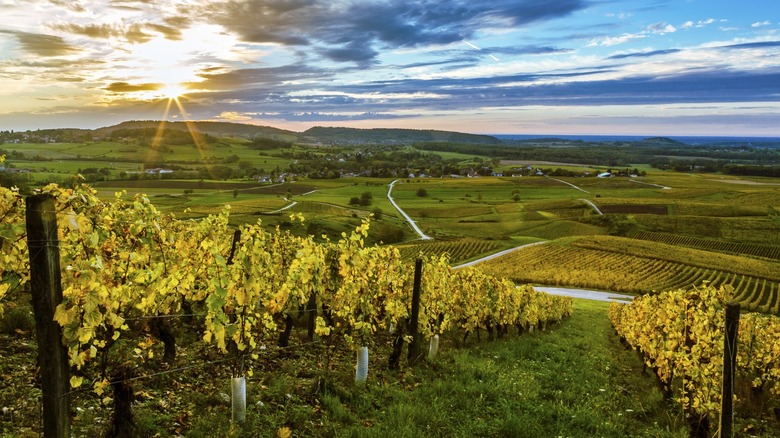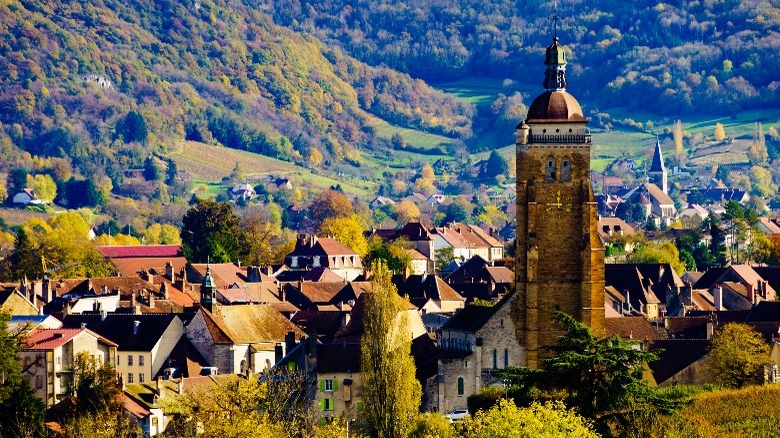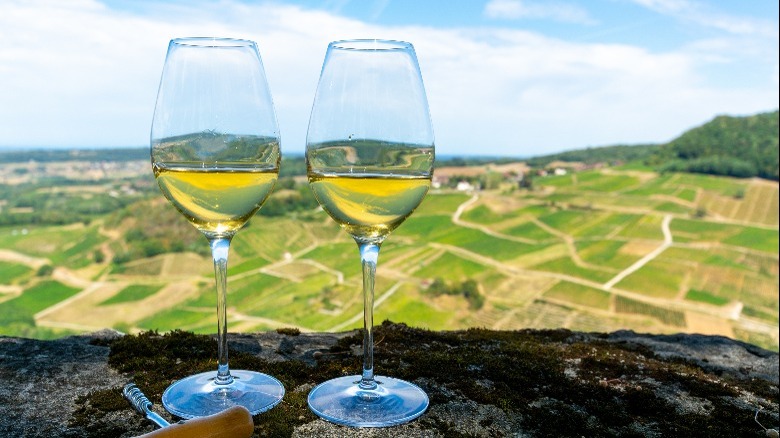This Under-The-Radar French Region Is The Perfect Wine Vacation Spot
Internationally renowned for its viticulture, France is one of the largest and most important wine producers in the world. From the reputed reds of Bordeaux to the acclaimed whites in the Loire Valley and the prestigious sparkling variety from Champagne, the country is home to no less than 12 major wine regions. However, while it's usually the big-hitters that get all the attention, it's well worth discovering some of the lesser-known areas too, and in particular, the smallest one of them all, the Jura.
Located on the border between France and Switzerland, at the foot of the Jura Mountains, what this winemaking region lacks in size, it more than makes up for with its much-vaunted "vins." Indeed, no longer the secret that it once was, the Jura is now regarded as one of the most up-and-coming French wine regions. For instance, in 2023, a producer from the area, Michel Tissot & Fils, scooped the French White Trophy in the prestigious International Wine Challenge (IWC) for its Château-Chalon Vin Jaune 2015.
What is more, while the vineyards may only cover a relatively small area, spanning some 50 miles, the wines here are surprisingly diverse — with a mix of white, red, yellow, straw-colored, and sparkling. Impressively, they also include seven "AOCs" (Appellation d'Origine Contrôlée), an important certification that guarantees the origin, quality, and/or authenticity of a product. Many of the wines are also produced using organic, natural or biodynamic methods.
The jewel in the crown of the Jura
The most celebrated of them all, however, is the region's "yellow wine" (or "vin jaune" that you might have spotted in the name of the aforementioned award-winner). Known as "the gold of the Jura", it is made exclusively from the Savagnin grape and stored in oak barrels for around six years using a special technique that allows a film of yeast (a "voile") to develop. The result is a mix of aromas ranging from hints of hazelnut and walnut to notes of dried fruit and spices.
In fact, so important is the region's golden wine, it even has its own annual festival to celebrate the opening of the new vintage. Held in early February, over two days, the host town puts on an array of events, ranging from wine tastings and cooking competitions to auctions of old vintages. Be sure to pick up a bottle to take home; you can't miss them, as they come in a distinctive smaller vessel called a "clavelin".
Otherwise, to discover the wider wine region, you can't beat simply following one of the tourist office's suggested trails. Along the way, you can visit winemakers in their vineyards, taste some of their wares, and visit the dedicated museum in the region's wine capital of Arbois — where the winemakers were among the first in France to obtain an AOC. Furthermore, it's all set against a beautiful backdrop of caves, chasms, waterfalls, lakes, valleys, cliffs, and mountain forests.
Other things to see and do in the region
On that note, the other great thing about the Jura is that, even fine wines aside, it's such a picturesque part of the world. An idyllic retreat for lovers of the outdoors, the mountains offer spectacular hiking, mountain biking, and even cross-country skiing. Certainly, if you do just one thing, be sure to see the magnificent waterfalls of the Hérisson valley — the highest of which is around 213 feet.
Among the other highlights is the pretty village of Baume-les-Messieurs, with its own nearby waterfall, limestone cliffs, and underground galleries, and which is ranked among the most beautiful in France. Then there are the caves you can visit, such as Gouffre de Poudrey, one of the largest underground chambers in France, located between Besançon and Pontarlier. Perhaps most surprisingly of all, there are no less than four UNESCO World Heritage Sites, two of which commemorate the area's long-held tradition of salt production. The other two are the 17th-century citadel and fortifications of Besançon, and the prehistoric sites of Chalain and Clairvaux.
Another plus point is that, despite the tranquility of this scenic landscape, the Jura is only three hours away from Paris on the high-speed train. It is therefore easily accessible, too. So, while it may be the smallest wine region in France, the Jura seriously punches above its weight, not only in the wine stakes but as a great destination all around.


